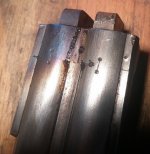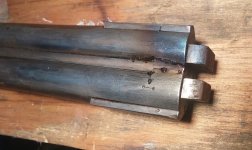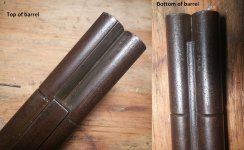mariner3302
Inactive
Hi, been a long time since I have been on forums. I need help with this from the collective. I bought this old gun in a small shop in Wyoming a little while ago. It is like nothing I have ever seen and has very interesting (spelled What the hell is THAT) features. It has also had its flash channels plugged. If anyone has ANY ideas of what this is, please chime in. There are no makers marks or stamps of any kind on it.
It was marked on the tag as a mid 1800's Howdah gun in the shop. The previous owner didn't furnish anymore info. I can believe this due to the thick barrels, no sights, and short length but again I have no idea. The identical grooves cut into the front of the barrels makes me wonder if it had either a bayonet, flash hider, or some sort of barrel cap to keep out the weather.
The large lug under the barrels that the ramrod goes through would suggest to me that it could be mounted on some sort of a swivel thus allowing the shooter to swing and engage immediately.
The hammers and action are in great shape and don't look like they have been used although at some point someone did snap them onto the nipples. The left nipple was mushroomed a bit. The nipples appear new and were loosely screwed into the barrels. The patchbox just looks a little off for an original and the grip butt has what I believe to be a cap holder. Again, it is just a little off. I wouldn't be surprised at all if someone said the barrels had been refitted to a different stock at some point.
Now the flash channels... they are filled with a hard metal, not lead and I don't think solder. First I tried to drill into it gently with a tiny bit but it barely cut into it although it did. I heated it with a torch thinking if it were solder that at least a little would soften but it didn't. I only heated them and poked at the metal. I didn't bring it up to glowing. What it DID do was to make the breech plugs weep out a bit of old black tarish stuff. Thereby I know where the plugs are generally located. I saw the flash channels where they come out inside the barrels and they are centered and look correct. It is hard to tell if they are plugged but I think probably although there isn't any indication that anything dripped into the barrels.
So, there it is... Anybody got some idea's? Or know where to go to find out more info?
It was marked on the tag as a mid 1800's Howdah gun in the shop. The previous owner didn't furnish anymore info. I can believe this due to the thick barrels, no sights, and short length but again I have no idea. The identical grooves cut into the front of the barrels makes me wonder if it had either a bayonet, flash hider, or some sort of barrel cap to keep out the weather.
The large lug under the barrels that the ramrod goes through would suggest to me that it could be mounted on some sort of a swivel thus allowing the shooter to swing and engage immediately.
The hammers and action are in great shape and don't look like they have been used although at some point someone did snap them onto the nipples. The left nipple was mushroomed a bit. The nipples appear new and were loosely screwed into the barrels. The patchbox just looks a little off for an original and the grip butt has what I believe to be a cap holder. Again, it is just a little off. I wouldn't be surprised at all if someone said the barrels had been refitted to a different stock at some point.
Now the flash channels... they are filled with a hard metal, not lead and I don't think solder. First I tried to drill into it gently with a tiny bit but it barely cut into it although it did. I heated it with a torch thinking if it were solder that at least a little would soften but it didn't. I only heated them and poked at the metal. I didn't bring it up to glowing. What it DID do was to make the breech plugs weep out a bit of old black tarish stuff. Thereby I know where the plugs are generally located. I saw the flash channels where they come out inside the barrels and they are centered and look correct. It is hard to tell if they are plugged but I think probably although there isn't any indication that anything dripped into the barrels.
So, there it is... Anybody got some idea's? Or know where to go to find out more info?
Attachments
Last edited:




